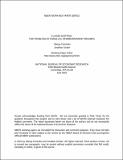| dc.contributor.author | Fomenko, Olesya | |
| dc.contributor.author | Gruber, Jonathan | |
| dc.date.accessioned | 2019-03-07T18:33:09Z | |
| dc.date.available | 2019-03-07T18:33:09Z | |
| dc.date.issued | 2016-12 | |
| dc.date.submitted | 2016-11 | |
| dc.identifier.issn | 0167-6296 | |
| dc.identifier.uri | http://hdl.handle.net/1721.1/120808 | |
| dc.description.abstract | Parallel reimbursement regimes, under which providers have some discretion over which payer gets billed for patient treatment, are a common feature of health care markets. In the U.S., the largest such system is under Workers’ Compensation (WC), where the treatment workers with injuries that are not definitively tied to a work accident may be billed either under group health insurance plans or under WC. We document that there is significant reclassification of injuries from group health plans into WC, or “claims shifting”, when the financial incentives to do so are strongest. In particular, we find that injuries to workers enrolled in capitated group health plans (such as HMOs) see a higher incidence of their claims for soft-tissue injuries (which are hard to classify specifically as work related) under WC than under group health, relative to those in non-capitated plans. Such a pattern is not evident for workers with traumatic injuries. Moreover, we find that such reclassification is more common in states with higher WC fees, once again for soft tissue but not traumatic injuries. Our results imply that a significant shift towards capitated reimbursement, or reimbursement reductions, under GH could lead to a large rise in the cost of WC plans. | en_US |
| dc.publisher | Elsevier BV | en_US |
| dc.relation.isversionof | http://dx.doi.org/10.1016/J.JHEALECO.2016.12.002 | en_US |
| dc.rights | Creative Commons Attribution-NonCommercial-NoDerivs License | en_US |
| dc.rights.uri | http://creativecommons.org/licenses/by-nc-nd/4.0/ | en_US |
| dc.source | NBER | en_US |
| dc.title | Claims-shifting: The problem of parallel reimbursement regimes | en_US |
| dc.type | Article | en_US |
| dc.identifier.citation | Fomenko, Olesya and Jonathan Gruber. “Claims-Shifting: The Problem of Parallel Reimbursement Regimes.” Journal of Health Economics 51 (January 2017): 13–25 © 2016 Elsevier B.V. | en_US |
| dc.contributor.department | Massachusetts Institute of Technology. Department of Economics | en_US |
| dc.contributor.mitauthor | Gruber, Jonathan | |
| dc.relation.journal | Journal of Health Economics | en_US |
| dc.eprint.version | Original manuscript | en_US |
| dc.type.uri | http://purl.org/eprint/type/JournalArticle | en_US |
| eprint.status | http://purl.org/eprint/status/NonPeerReviewed | en_US |
| dc.date.updated | 2019-02-11T18:05:54Z | |
| dspace.orderedauthors | Fomenko, Olesya; Gruber, Jonathan | en_US |
| dspace.embargo.terms | N | en_US |
| dc.identifier.orcid | https://orcid.org/0000-0002-9877-3065 | |
| mit.license | PUBLISHER_CC | en_US |
